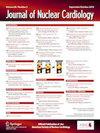AI-enabled CT-guided end-to-end quantification of total cardiac activity in 18FDG cardiac PET/CT for detection of cardiac sarcoidosis
IF 3
4区 医学
Q2 CARDIAC & CARDIOVASCULAR SYSTEMS
引用次数: 0
Abstract
Background
[18F]-fluorodeoxyglucose ([18F]FDG) positron emission tomography (PET) plays a central role in diagnosing and managing cardiac sarcoidosis. We propose a fully automated pipeline for quantification of [18F]FDG PET activity using deep learning (DL) segmentation of cardiac chambers on computed tomography (CT) attenuation maps and evaluate quantitative approaches based on this framework.
Methods
We included consecutive patients undergoing [18F]FDG PET/CT for suspected cardiac sarcoidosis. DL segmented left atrium, left ventricle (LV), right atrium, right ventricle, aorta, LV myocardium, and lungs from CT attenuation scans. CT-defined anatomical regions were applied to [18F]FDG PET images automatically to quantify target to background ratio (TBR), volume of inflammation (VOI) and cardiometabolic activity (CMA) using full sized and shrunk segmentations.
Results
A total of 69 patients were included, with mean age of 56.1 ± 13.4 and cardiac sarcoidosis present in 29 (42 %). CMA had highest prediction performance (area under the receiver operating characteristic curve [AUC] .919, 95 % confidence interval [CI] .858 – .980) followed by VOI (AUC .903, 95 % CI .834 – .971), TBR (AUC .891, 95 % CI .819 – .964), and maximum standardized uptake value (AUC .812, 95 % CI .701 – .923). Abnormal CMA (≥1) had a sensitivity of 100 % and specificity 65 % for cardiac sarcoidosis. Lung quantification was able to identify patients with pulmonary abnormalities.
Conclusion
We demonstrate that fully automated volumetric quantification of [18F]FDG PET for cardiac sarcoidosis based on CT attenuation map-derived volumetry is feasible, rapid, and has high prediction performance. This approach provides objective measurements of cardiac inflammation with consistent definition of myocardium and background region.

基于ai的CT引导下对18FDG心脏PET/CT总心脏活动进行端到端定量,用于检测心脏结节病。
背景:[18F]-氟脱氧葡萄糖([18F]FDG)正电子发射断层扫描(PET)在心脏结节病的诊断和治疗中起着核心作用。我们提出了一种全自动管道,利用计算机断层扫描(CT)衰减图上的心室深度学习(DL)分割来量化[18F]FDG PET活性,并基于该框架评估定量方法。方法:我们纳入了连续接受[18F]FDG PET/CT检查的疑似心脏结节病患者。DL分节左心房、左心室、右心房、右心室、主动脉、左室心肌和肺的CT衰减扫描。将ct定义的解剖区域自动应用于[18F]FDG PET图像,使用全尺寸和缩小的分割来实现靶背景比(TBR)、炎症体积(VOI)和心脏代谢活性(CMA)。结果:共纳入69例患者,平均年龄56.1±13.4岁,29例(42%)存在心脏结节病。CMA预测效果最好(受试者工作特征曲线下面积[AUC] 0.919, 95%可信区间[CI] 0.858 ~ 0.980),其次是VOI (AUC 0.903, 95% CI 0.834 ~ 0.971)、TBR (AUC 0.891, 95% CI 0.819 ~ 0.964)和最大标准化摄取值(AUC 0.812, 95% CI 0.701 ~ 0.923)。异常CMA(≥1)对心脏结节病的敏感性为100%,特异性为65%。肺量化能够识别肺部异常的患者。结论:我们证明了基于CT衰减图衍生的容积法对[18F]FDG PET进行心脏结节病全自动容积定量是可行的,快速的,并且具有很高的预测性能。这种方法提供了客观的测量心脏炎症与一致的定义心肌和背景区域。摘要:我们开发了一种全自动管道,用于疑似心脏结节病患者的[18F]-氟脱氧葡萄糖([18F]FDG) PET定量。先前验证的深度学习模型从计算机断层扫描中分割心室,然后量化目标与背景比,炎症体积和心脏代谢活性(CMA)。共纳入69例患者,其中29例(42%)存在心脏结节病。CMA在受试者工作特征曲线下的面积最大(0.919,95%可信区间0.858 ~ 0.980)。全自动体积定量[18F]FDG PET是可行的,对心脏结节病具有较高的预测性能。
本文章由计算机程序翻译,如有差异,请以英文原文为准。
求助全文
约1分钟内获得全文
求助全文
来源期刊
CiteScore
5.30
自引率
20.80%
发文量
249
审稿时长
4-8 weeks
期刊介绍:
Journal of Nuclear Cardiology is the only journal in the world devoted to this dynamic and growing subspecialty. Physicians and technologists value the Journal not only for its peer-reviewed articles, but also for its timely discussions about the current and future role of nuclear cardiology. Original articles address all aspects of nuclear cardiology, including interpretation, diagnosis, imaging equipment, and use of radiopharmaceuticals. As the official publication of the American Society of Nuclear Cardiology, the Journal also brings readers the latest information emerging from the Society''s task forces and publishes guidelines and position papers as they are adopted.

 求助内容:
求助内容: 应助结果提醒方式:
应助结果提醒方式:


